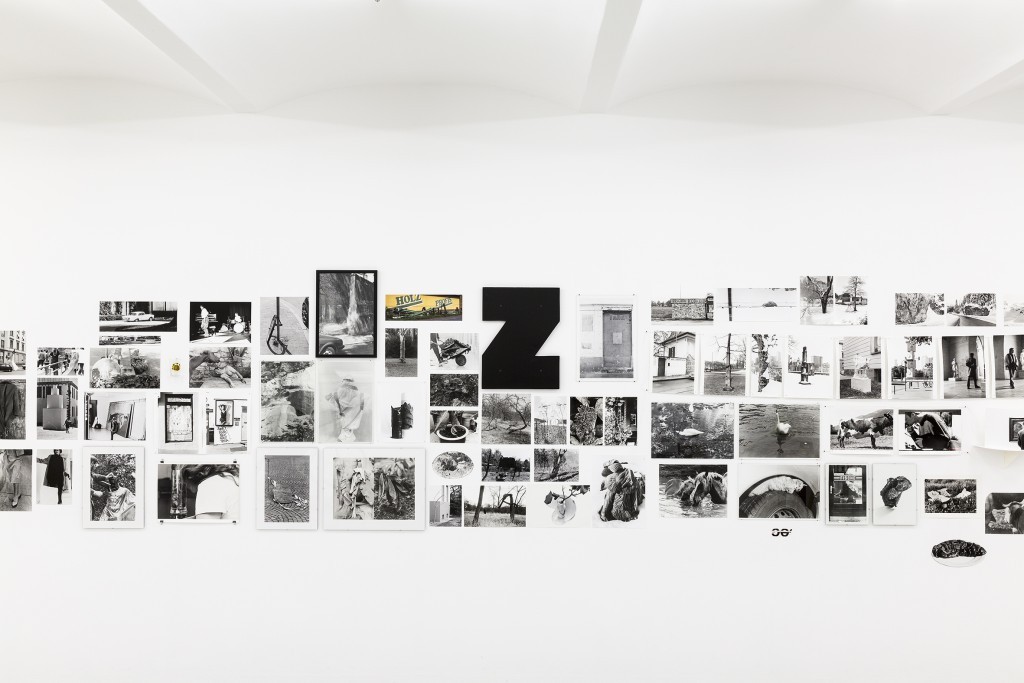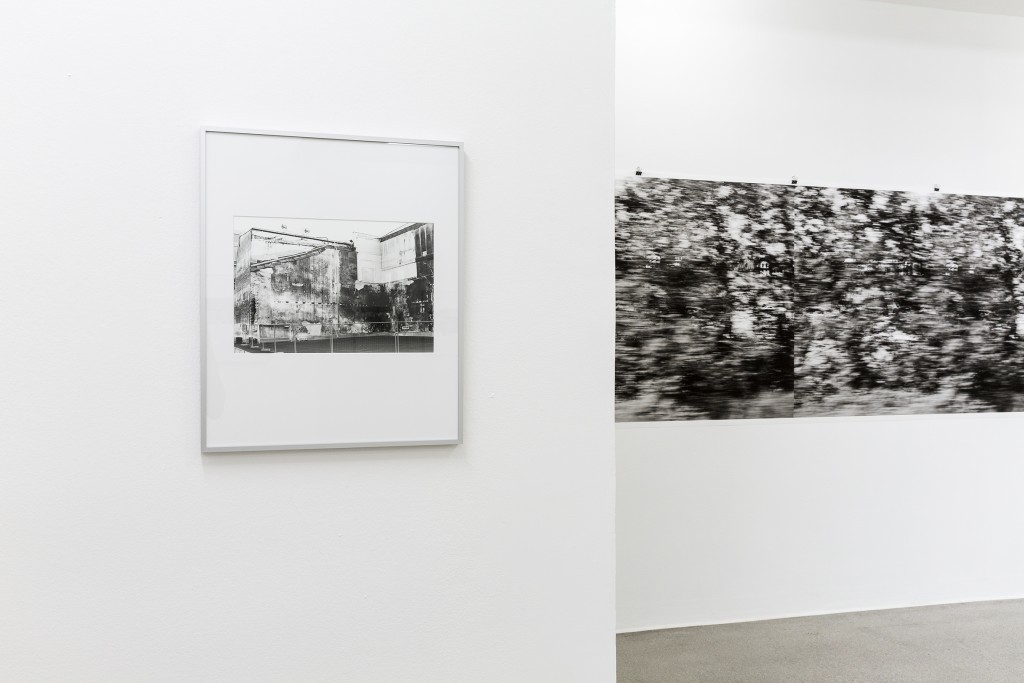Gerald Domenig
Awåragaude?
22 Apr - 19 Jun 2016
GERALD DOMENIG
Awåragaude?
22 April – 19 June 2016
Photography, drawing, and writing (texts) are the preferred genres of the Austrian artist Gerald Domenig, who lives in Frankfurt am Main. He has worked in these media since the 1970s, building a sizable oeuvre distinguished by formal consistency and thematic openness. In Domenig’s work, drawing and photography figure as two registers that serve diametrically opposed purposes with regard to a construction of reality. His drawings are intended as drafts or preliminary sketches for photographs: his work with the pencil may be conceived as a tentative exploration of the world. By contrast, the photographs—most of them are black-and-white—are not just snapshots capturing moments; aiming at more than a rendition of reality, they are always self-contained images of a situation, a place. Domenig, who uses an analog camera, develops the films by hand, and makes his own prints, sees photography as a technique of visual construction, of the transformation of space into surface and the resolution of what was before the camera’s lens into a pictorial creation. “When I make photographs, I want to translate an image hidden in the three-dimensional world, a latent flatness, into a concrete picture,” Domenig says.
Recurrent motifs (though his true “motif” is photography itself) include coats, trousers, houses, cars—everyday things, found objects, like the pair of gloves a child must have lost in the street. What he finds in small things he then recreates in his studio, in staged scenes that aim for the greatest possible simplicity and starkness. Unprepossessing façades and corners of houses, weather-beaten walls or ones that show traces of structural alterations: these are of particular interest to the artist—surfaces of non-places in which he discovers painterly details that remind him of works by Sol LeWitt, Mark Rothko, and others. One location where Domenig has taken photographs for many years are the gorges of the Garnitzenklamm in the Gailtal region of southern Austria. In his pictures, the spectacular scenery’s three dimensions collapse into a strange flatness. Domenig likes to highlight formal analogies between his pictures, splicing them along what he calls a “suture” and presenting them on facing pages of a book.
Gerald Domenig’s exhibition at the Secession presents a selection from his photographic and graphic oeuvres, with an emphasis on still lifes and architecture photography; new pictures are juxtaposed with first prints of negatives that have sat in his archive for some time. Ambiguity with regard to form as well as content, an unsettling destabilization of spatial perception that grows out of the picture itself, is characteristic of Domenig’s photographic practice and served as the guiding idea behind the selection of the works on display.
The arrangement in the first room shows an array of architectonic structures and details such as façades and windows. Two series are presented face to face: pictures Domenig took during several stays in Antwerp on the one side, and photographs of the façade of a building slated for demolition in the vicinity of the Secession that he captured during a recent trip to Vienna on the other.
The second room, where Dike Blair’s Drinks, a set of still lifes in small formats, were on view in the previous exhibition, is once again dedicated to still lifes: small-format photographs of bowls in peculiar nested arrangements, broken china, and plastic containers for film reels coiled around tumblers. Here, too, Domenig draws us into a play with unstable perspectives; like Rorschach images, the compositions are hard to pin down.
A certain sense of rigidity that may be felt to prevail in the first two rooms due to the hanging and the focus on a single genre is dispelled in the exhibition’s final room. A seating sculpture, a selection of twenty-four drawings, and a collage-like compilation of diverse pictures covering a large part of the long wall make for a playful situation, inviting the visitor to draw cross-connections. Photographic copies of newspaper pages and advertising posters appear side by side with “legitimate” photographs (identified as such by their frames), unconventionally treated prints, isolated motifs, and “leftovers.” The forms of presentation are no less varied: some pictures are pinned directly to the wall in the manner of posters, while others have been laminated onto warped supports for a sculptural effect; yet others appear in classic frames.
Language is another important medium of expression and material in Gerald Domenig’s art. His work on his pictures goes hand in hand with an ongoing production of texts: lectures, speeches, and catalogue essays that combine reflections on his art with anecdotal elements. For his artist’s book Mittendrin ein Z, he has written an extensive essay that touches on many of the subjects his photographs examine. The text not only offers insights into how the artist thinks and writes, it also explains the exhibition’s title:
“The title of my show [Awåragaude?] is meant to prompt the visitors and all those who read it somewhere and are baffled by it because they’re unfamiliar with the German spoken in Carinthia to ask: What on earth does that mean? We might then reply: Well, you know, artists! Always ahead of their time. You [...] haven’t even been inside the exhibition and he already wants to know whether you liked it. Awåragaude? Did you like it, “was it fun”?
It’s a question G.D. grew up with. When he came home from school, the question wasn’t: So what did we learn today? When he came home from playing soccer, his knees all scratched up, the question wasn’t: Did you win? When, one November, he returned from a hitchhiking trip to Venice, the question wasn’t: Did you have fog? No, the question was always: Awåragaude?
G.D. believes it’s a good question, or certainly one that sounds good and is worthy of a globalized world, with the Latin echo in Gaude (pleasure, fun), and he wants to do his part to preserve this cultural heritage by prominently featuring it ...”
Awåragaude?
22 April – 19 June 2016
Photography, drawing, and writing (texts) are the preferred genres of the Austrian artist Gerald Domenig, who lives in Frankfurt am Main. He has worked in these media since the 1970s, building a sizable oeuvre distinguished by formal consistency and thematic openness. In Domenig’s work, drawing and photography figure as two registers that serve diametrically opposed purposes with regard to a construction of reality. His drawings are intended as drafts or preliminary sketches for photographs: his work with the pencil may be conceived as a tentative exploration of the world. By contrast, the photographs—most of them are black-and-white—are not just snapshots capturing moments; aiming at more than a rendition of reality, they are always self-contained images of a situation, a place. Domenig, who uses an analog camera, develops the films by hand, and makes his own prints, sees photography as a technique of visual construction, of the transformation of space into surface and the resolution of what was before the camera’s lens into a pictorial creation. “When I make photographs, I want to translate an image hidden in the three-dimensional world, a latent flatness, into a concrete picture,” Domenig says.
Recurrent motifs (though his true “motif” is photography itself) include coats, trousers, houses, cars—everyday things, found objects, like the pair of gloves a child must have lost in the street. What he finds in small things he then recreates in his studio, in staged scenes that aim for the greatest possible simplicity and starkness. Unprepossessing façades and corners of houses, weather-beaten walls or ones that show traces of structural alterations: these are of particular interest to the artist—surfaces of non-places in which he discovers painterly details that remind him of works by Sol LeWitt, Mark Rothko, and others. One location where Domenig has taken photographs for many years are the gorges of the Garnitzenklamm in the Gailtal region of southern Austria. In his pictures, the spectacular scenery’s three dimensions collapse into a strange flatness. Domenig likes to highlight formal analogies between his pictures, splicing them along what he calls a “suture” and presenting them on facing pages of a book.
Gerald Domenig’s exhibition at the Secession presents a selection from his photographic and graphic oeuvres, with an emphasis on still lifes and architecture photography; new pictures are juxtaposed with first prints of negatives that have sat in his archive for some time. Ambiguity with regard to form as well as content, an unsettling destabilization of spatial perception that grows out of the picture itself, is characteristic of Domenig’s photographic practice and served as the guiding idea behind the selection of the works on display.
The arrangement in the first room shows an array of architectonic structures and details such as façades and windows. Two series are presented face to face: pictures Domenig took during several stays in Antwerp on the one side, and photographs of the façade of a building slated for demolition in the vicinity of the Secession that he captured during a recent trip to Vienna on the other.
The second room, where Dike Blair’s Drinks, a set of still lifes in small formats, were on view in the previous exhibition, is once again dedicated to still lifes: small-format photographs of bowls in peculiar nested arrangements, broken china, and plastic containers for film reels coiled around tumblers. Here, too, Domenig draws us into a play with unstable perspectives; like Rorschach images, the compositions are hard to pin down.
A certain sense of rigidity that may be felt to prevail in the first two rooms due to the hanging and the focus on a single genre is dispelled in the exhibition’s final room. A seating sculpture, a selection of twenty-four drawings, and a collage-like compilation of diverse pictures covering a large part of the long wall make for a playful situation, inviting the visitor to draw cross-connections. Photographic copies of newspaper pages and advertising posters appear side by side with “legitimate” photographs (identified as such by their frames), unconventionally treated prints, isolated motifs, and “leftovers.” The forms of presentation are no less varied: some pictures are pinned directly to the wall in the manner of posters, while others have been laminated onto warped supports for a sculptural effect; yet others appear in classic frames.
Language is another important medium of expression and material in Gerald Domenig’s art. His work on his pictures goes hand in hand with an ongoing production of texts: lectures, speeches, and catalogue essays that combine reflections on his art with anecdotal elements. For his artist’s book Mittendrin ein Z, he has written an extensive essay that touches on many of the subjects his photographs examine. The text not only offers insights into how the artist thinks and writes, it also explains the exhibition’s title:
“The title of my show [Awåragaude?] is meant to prompt the visitors and all those who read it somewhere and are baffled by it because they’re unfamiliar with the German spoken in Carinthia to ask: What on earth does that mean? We might then reply: Well, you know, artists! Always ahead of their time. You [...] haven’t even been inside the exhibition and he already wants to know whether you liked it. Awåragaude? Did you like it, “was it fun”?
It’s a question G.D. grew up with. When he came home from school, the question wasn’t: So what did we learn today? When he came home from playing soccer, his knees all scratched up, the question wasn’t: Did you win? When, one November, he returned from a hitchhiking trip to Venice, the question wasn’t: Did you have fog? No, the question was always: Awåragaude?
G.D. believes it’s a good question, or certainly one that sounds good and is worthy of a globalized world, with the Latin echo in Gaude (pleasure, fun), and he wants to do his part to preserve this cultural heritage by prominently featuring it ...”


